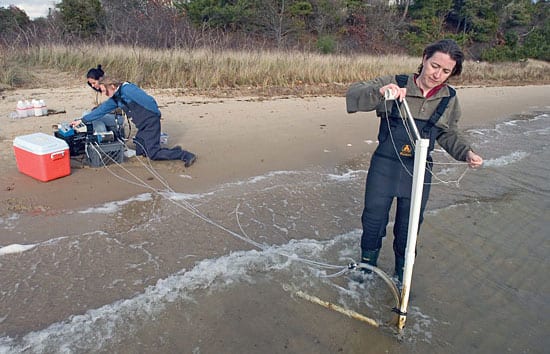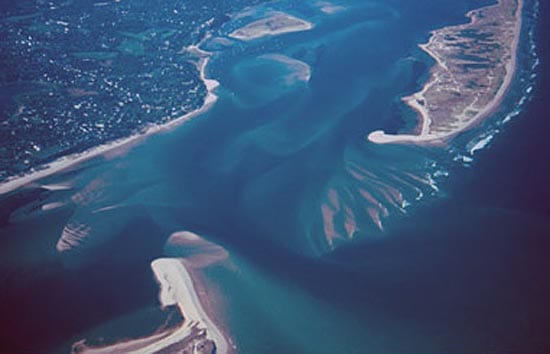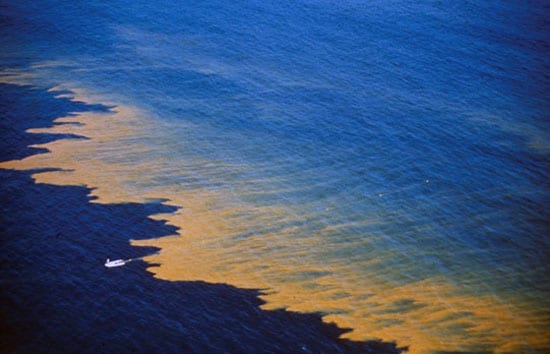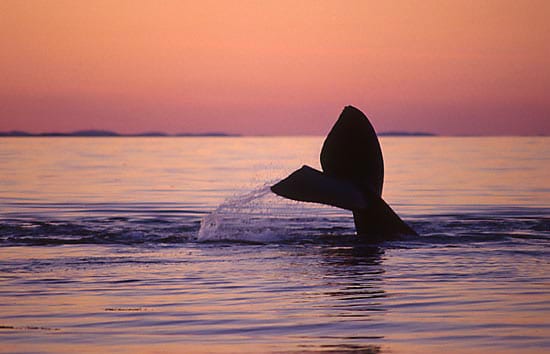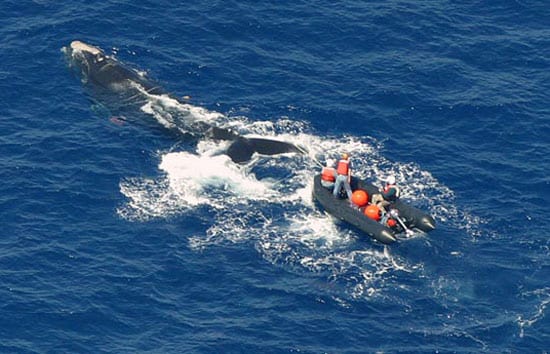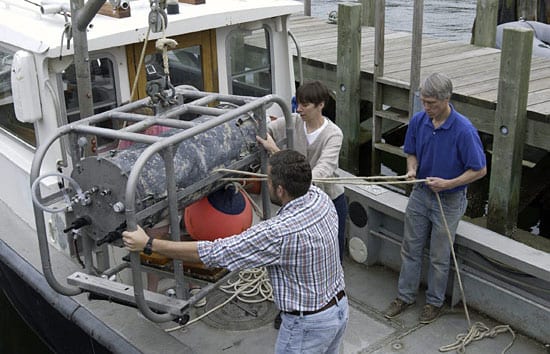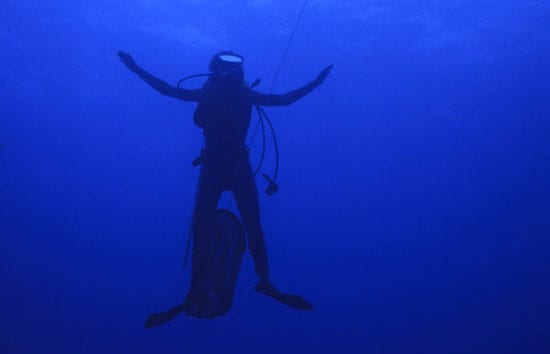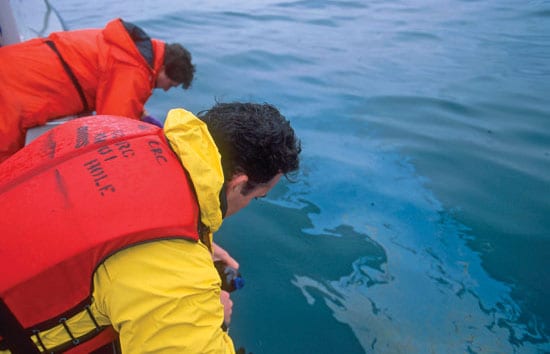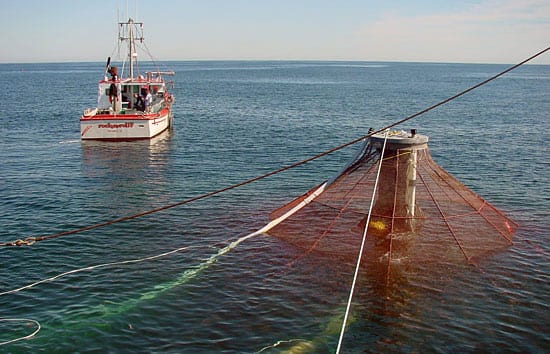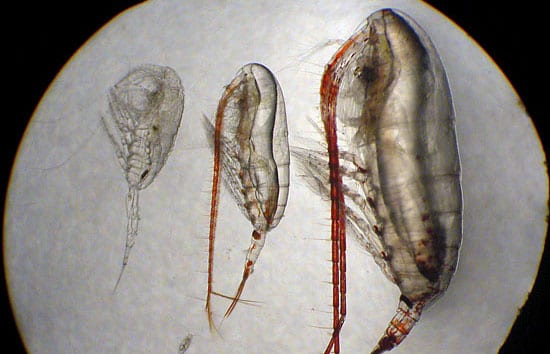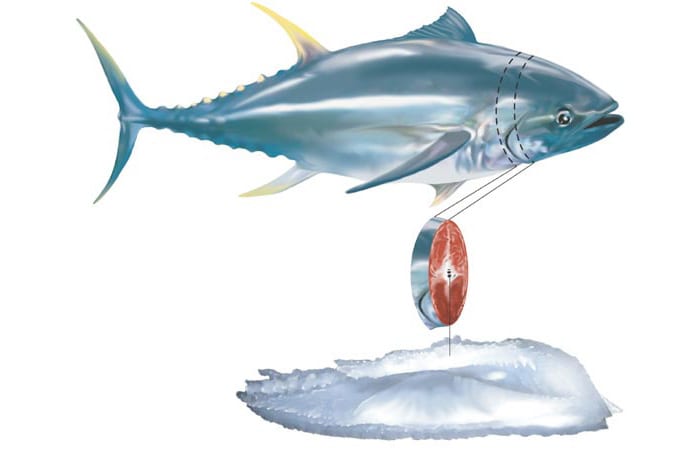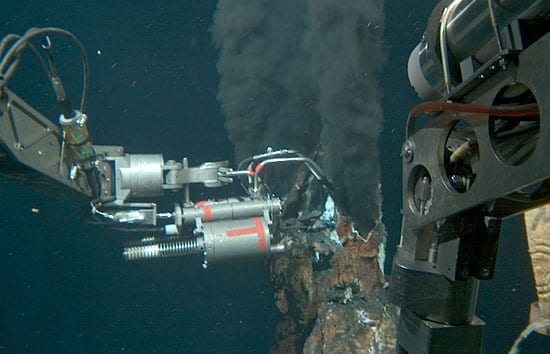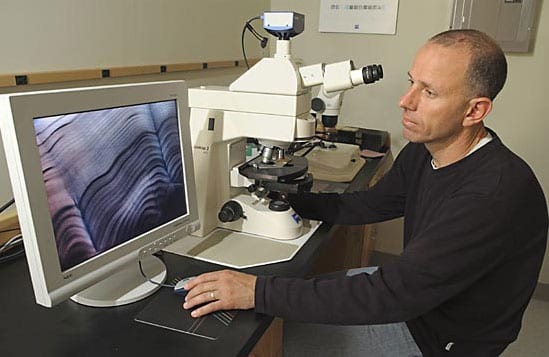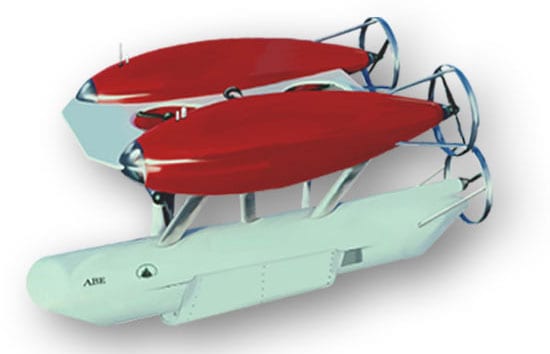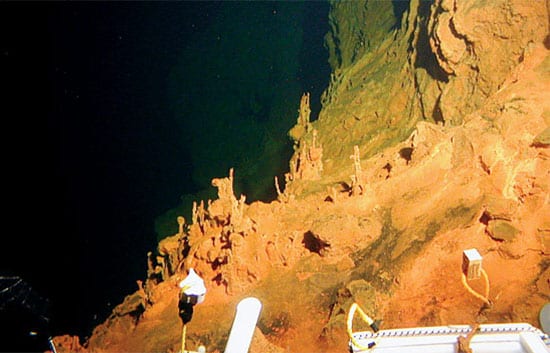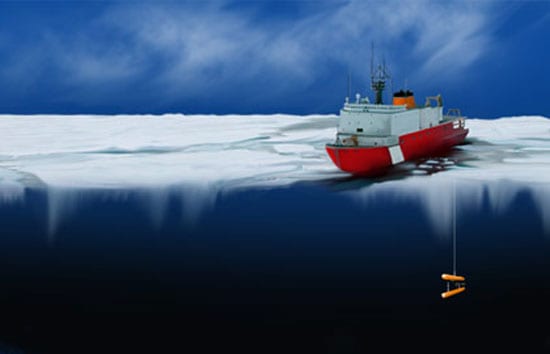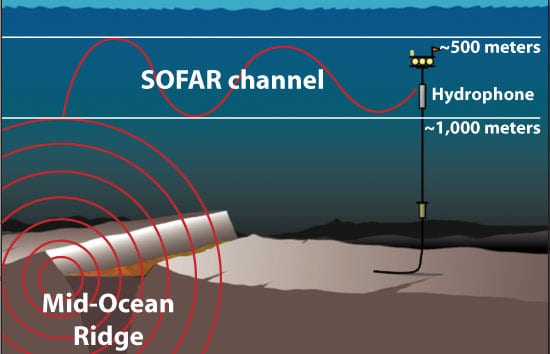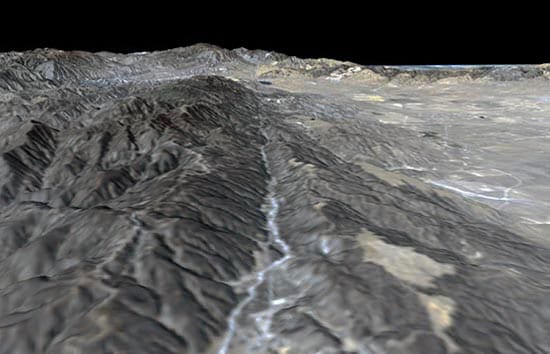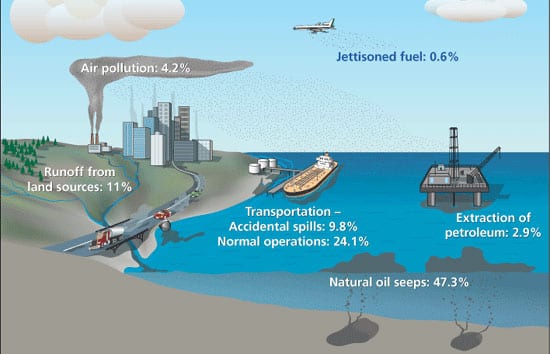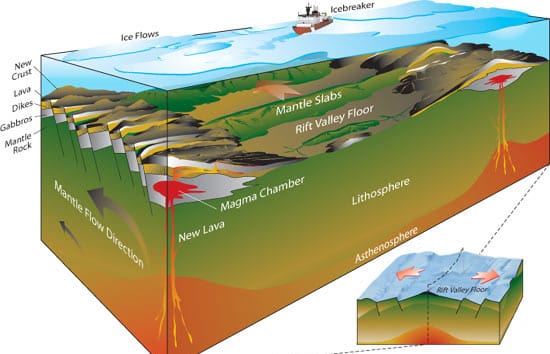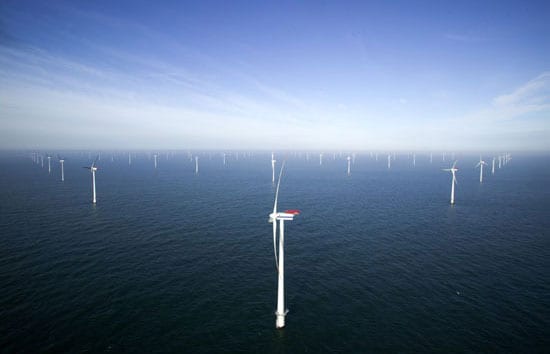Feature
Water Flowing Underground
Groundwater discharge appears to be an important factor for determining the chemistry of the coastal ocean. As fresh groundwater flows toward the sea, it rises up over denser, salty water. The fresh and salty water mix along the interface, and the resulting fluid discharges at the shoreline. This interface between underground water masses has recently been described as a “subterranean estuary,” a mixing zone between fresh and salty water analogous to the region where a river meets the ocean.
Read MoreRising Sea Levels and Moving Shorelines
Changes to the shoreline are inevitable and inescapable. Shoals and sandbars become islands and then sandbars again. Ice sheets grow and shrink, causing sea level to fall and rise as water moves from the oceans to the ice caps and back to the oceans. Barrier islands rise from the seafloor, are chopped by inlets, and retreat toward the mainland. Even the calmest of seas are constantly moving water, sand, and mud toward and away from the shore, and establishing new shorelines.
The Growing Problem of Harmful Algae
Harmful algal blooms are natural and they are not new. But ocean scientists are growing concerned that they are now all too common. The unprecedented growth of human activities in coastal watersheds—including agriculture, aquaculture, industry, housing, and recreation—has drastically increased the amount of fertilizer flowing into coastal waters and fueled unwanted algal growth.
Read MoreIntroducing…the Asian Oyster
As native oysters decline, officials seek to restore fishery with disease-resistant species “O Oysters,” said the Carpenter, “You’ve had a pleasant run! Shall we be trotting home again?” But answer…
Read MoreScientists Muster to Help Right Whales
It is a sad irony that we have cataloged individual photographs of the remaining North Atlantic right whales and given each of them unique numbers and sometimes names, yet still know too little about their physiology, behavior, and habitats to take effective steps toward ensuring their survival as a species.
Read MoreWhither the North Atlantic Right Whale?
“Today only a remnant of the population survives, no more than 350 whales clustered in calving and feeding grounds along the eastern seaboard of North America. Only occasional right whale sightings in the Gulf of St. Lawrence or in the waters between Iceland, Greenland, and Norway give echoes of their once substantially greater range.
Read MoreRevealing the Ocean’s Invisible Abundance
Finding minuscule life forms in a seemingly infinite ocean isn’t trivial. But in recent years, oceanographers have been developing new techniques and instruments to identify and count marine microorganisms. Year by year, we are learning more and more about them and discovering that they are even more numerous, varied, and important than we previously thought.
Read MoreShedding Light on Light in the Ocean
Light in the ocean is like light in no other place on Earth. It is a world that is visibly different from our familiar terrestrial world, and one that marine animals, plants, and microbes are adapted to in extraordinary ways. Light behaves very differently when it moves from air into water. It moves through the expansive depths of an ocean that is devoid of solid surfaces. These and other factors combine to create an environment that has no equivalent on land.
Read MoreOil in Our Coastal Back Yard
On September 16, 1969, the barge Florida ran aground off Cape Cod, rupturing its hull and spilling 189,000 gallons of No. 2 fuel oil. Winds and waves pushed the oil onto the beaches and marshes of West Falmouth, Massachusetts, carrying with it dead lobsters, scup, and cod.
Read MoreShaping the Beach, One Wave at a Time
For years, scientists who study the shoreline have wondered at the apparent fickleness of storms, which can devastate one part of a coastline, yet leave an adjacent part untouched. How can this be? The answer lies in the physics of the nearshore region?the stretch of sand, rock, and water between the dry land behind the beach and the beginning of deep water far from shore.
Read MoreDown on the Farm…Raising Fish
Aquaculture, or fish farming, is changing how we think about one of our main sources of protein. With many fish stocks shrinking due to overfishing or environmental degradation, aquaculture holds the promise of more reliable and more sustainable seafood production. The economic and social benefits could be significant for both consumers and producers.
Read MoreLife in the Arctic Ocean
Capped with a formidable ice and snow cover, plunged into total darkness during the winter, buffeted by blizzard winds,and bitterly cold, the Arctic Ocean is one of the most inaccessible and yet beautiful environments on Earth. Life here endures some of the greatest extremes in light and temperature known to our planet. Yet despite these inhospitable conditions, the Arctic Ocean is teeming with life.
Read MoreIn Tiny Ear Bones, the Life Story of a Giant Bluefin Tuna
The Atlantic bluefin tuna, Thunnus thynnus, is one of the fastest, most powerful and most beautiful of fish. It is also the most expensive. Highly prized by sushi connoisseurs, a…
Read MoreThe Deep Ocean Exploration Institute
This may sound like heresy, but for some of us at Woods Hole Oceanographic Institution, the ocean is a bit of a nuisance. All that lovely blue water can get in the way.
Read MoreThe Secret Lives of Fish
“We have found that otoliths of fish born in each of the five natal estuaries had different, unique isotope and element compositions, or “signatures.” All their lives, these fish had carried a natural tag, encoding the location where they were hatched.
Read MoreRealizing the Dreams of da Vinci and Verne
Leonardo da Vinci made the first drawings of a submarine more than 500 years ago, and Jules Verne published 20,000 Leagues Under the Sea in 1875. But only in the past few decades has the dizzying pace of technological advances allowed us to realize their dreams of exploring the ocean depths and taking humans to the seafloor.
Read MoreLiving Large in Microscopic Nooks
Newly discovered deep-sea microbes rearrange thinking on the evolution of the Eart—and life on it.
Read MoreUnique Vehicles for a Unique Environment
For climatologists and physical oceanographers, it is often said that the Arctic is a canary in the environmental coal mine. In the isolated Arctic Ocean Basin, a variety of oceanographic and other processes have conspired to create a layer of cold, salty water called a halocline, which shields the sea ice from underlying warmer waters that would otherwise melt it.
Read MoreEars in the Ocean
If you sought to delve into the forces that drive and shape the face of the earth and that distinguish it from all other planets in our solar system, you would shine a spotlight on the mid-ocean ridges.
Read MoreEarthshaking Events
When I was still a schoolboy in China, two major earthquakes occurred, about a year apart. They had a profound impact on my life and on the Chinese people. The…
Read MoreMixing Oil and Water
In recent decades scientists have made substantial progress in understanding how oil enters the oceans, what happens to it, and how it affects marine organisms and ecosystems. This knowledge has led to regulations, practices, and decisions that have helped us reduce sources of pollution, prevent and respond to spills, clean up contaminated environments, wisely dredge harbors, and locate new petroleum handling facilities.
Read MorePeering into the Crystal Fabric of Rocks
“Rock solid” is an oxymoron, to my way of thinking. Oh, the expression does have some truth in that minuscule, superficial portion of our planet where humans dwell. But the majority of rocks nearly everywhere else in the earth are continually changing their physical characteristics.
Read MoreEarth’s Complex Complexion
Even as you read this, Earth’s crust is continually being reborn and recycled in a dynamic process that fundamentally shapes our planet. We’re not generally aware of all this action because most of it occurs at the seafloor, under a formidable watery shroud, and often in remote regions of the oceans.
Read MoreWhich Way Will the Wind Blow?
Wind energy is the fastest-growing sector of the global electric power industry, and several companies have proposed to build large wind turbines and utility-scale electric power-generating facilities in the coastal waters of the United States. Such facilities could change the way people use the ocean, and the public is divided over the costs and benefits. The environmental and economic benefits of renewable, nonpolluting sources of energy are clear. But there may be side effects from the placement of modern wind farms in the ocean, including the degradation of seascapes, impacts on birds and marine animals, and the disruption of existing patterns of human use of the ocean. The laws and regulations related to the placement of wind turbines in the ocean are at best rudimentary and inchoate; at worst, they are non-existent. Marine scientists and engineers can make an important contribution to this growing public debate by clarifying our understanding of the nature of these side effects. They might also inform public policies that balance the value of various ocean resources with the rights and interests of all who wish to use them.
Read More
